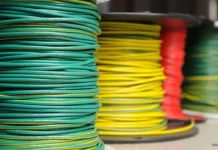Imagine being in the middle of creating your podcast, or YouTube video, and all you hear is, “BANG, BANG, BANG.”
Your neighbors are angry because according to them, you’re “Making too much noise”.
Sound familiar?
If you want to reduce noise in your home or business, it’s important to know the different types of soundproofing materials that exist today. But what materials best reduce the transmission of sound? From insulation to soundproofing materials that can be hung on the ceiling and walls, there are tons of great options.
Keep reading to learn the different types of soundproofing materials that will help you record in the best home studio!
Curtains and Drapes
Curtains and drapes are a type of soundproofing material that is used to cover windows. They act as both an insulator and dampener, creating two types of sound barriers.
One barrier causes the waves to bounce off the surface of the curtains while the other absorbs them as regular insulation would.
People tend to think that heavy curtains are more likely to block out sound.
In reality, the amount of noise that is canceled out relies on how well a curtain can hold onto its fabric. This means the material itself holds the secret to blocking out sounds and not necessarily how thick or heavy it is.
Acoustic Panels
Acoustic panels and systems are made up of several different layers. Their main goal is to decrease the amount of noise that can pass through them by creating an obstacle in the path between you and the sound.
Although these materials don’t completely block out outside noises, they do help minimize them quite significantly. These types of barriers can be broken down into three basic components:
The core layer forms the foundation for the entire panel and its main function is to absorb sounds. This means most acoustic panels tend to have some sort of foam or fiberglass insulation as their base.
The second layer consists mainly of strong fabric and acts as a support structure for both itself and any objects that may be hanging from it.
This fabric can be a bit thicker than the previous layer and is usually made from a tight weave to help prevent any sounds from getting through.
The final layer acts as a sound barrier and is probably the most important part of the entire process. It’s generally where the soundproofing material earns its name by actually blocking out incoming noises.
Insulation
Most people think of insulation as a way to prevent heat from escaping their homes during the colder months. However, insulation can also be used to soundproof walls.
This type of residential soundproofing material is often added to either reduce the noise levels in a room or absorb some of it.
For this material to work best, all holes and other openings should be sealed off so that sounds cannot escape or enter via another route.
It’s best if there is no air leakage since even small spaces can allow large amounts of noise through when condensed with outside forces. You can learn more here.
Decoupling Products
Decoupling products are another effective method that people use to keep outside noises from entering or leaving. These materials create a physical barrier between the sound and whatever it may be traveling through.
Although they do not absorb any of the noise, they will still help reduce echoes, vibrations, and other disturbances within your home’s walls by slowing them down.
Acoustic Flooring
Acoustic flooring can be used to suppress noise levels in both your home and garage. These types of materials usually consist of several different layers which work together to reduce the number of sounds that can pass through.
For this product to work properly, you must first install a strong foundation (usually concrete) and then lay down acoustic underlayment before adding any type of flooring on top.
Afterward, you simply need to add some finishing touches like baseboards and other trim pieces around the perimeter.
Acoustic wall panels should be added along with other insulation as well as ceiling tiles which also help trap any remaining sound inside so it doesn’t escape.
Soundproof Windows
Windows can play a big part in keeping noise from entering your home. Today’s homeowners have the option of choosing between many different types depending on their specific needs and budgets.
The first type is double hung windows which use gravity to hold them open without any extra support like counterweights.
These are often used as the main source of ventilation for any room where fresh air is crucial such as kitchen or bathrooms since they provide an easy way to get rid of excess moisture that occurs during daily activities.
The second option is called triple track windows because they come with three separate sashes (panels) instead of two like other designs.
This allows you to create a tight seal against the outside and lets you close either one or all three of them when needed.
Soundproof Doors
An easy way to increase the soundproofing capabilities in your home is by installing a new door. This will help prevent noise from getting inside while keeping it from escaping outside as well.
The first option is a solid core wood door which has a traditional design but includes a special membrane between the interior and exterior so you can keep unwanted sounds out without having to reduce airflow.
The second choice is a metal door, which provides better protection than any other type of barrier available today without losing too much airflow either.
Acoustic Ceiling Tiles
An effective way to both soundproof and insulate your home is by using ceiling tiles. They make these from multiple layers which absorb all types of noise while keeping them inside the area.
The first type of tiles works best for rooms with high ceilings. You use them on the ceiling without any other material in the middle.
The second option is a false ceiling because it includes beams to support the insulation. This way, sounds cannot get through or escape from the top level of the room.
Get the Right Soundproofing Materials For Your Needs!
Soundproofing materials come in a variety of shapes and sizes. If you’re looking to add soundproofing features to your space, the best thing you can do is consult an experienced professional who knows what will work for your specific needs.
Want more articles like this? Check out our blog!

































